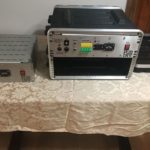Public Inventor(s):
Lawrence R. Kincheloe III, Forrest Lee Erickson, Geoff Mulligan, Ben Coombs, Robert Read
Motivation:
The NASA-MCOG project focuses on developing a control system to support NASA’s Ceramic Oxygen Generation (COG) technology, which is critical for improving life support in space. Originating from previous open-source projects, the control system uses microcontroller-based architecture, including a state machine and hardware abstraction. The ultimate goal is to enhance space-based oxygen production while also having potential applications for improving global health in rugged or rural communities. This project follows an open-source model, with code and designs made publicly accessible for broader contributions and improvements.
Check out how the efforts of this project are helping other organizations, like KidsOR, to bring oxygen generating sources to low income countries to save lives: https://www.kidsor.org/news/nasa-kidsor/
Story:
The NASA-MCOG project began with a simple goal: to create a control system for ceramic oxygen generation technology. Initially built as a fork from earlier open-source projects, it focused on using microcontroller platforms to control key variables such as temperature and voltage. Over time, the team adapted its approach to include more complex systems like finite state machines, hardware abstraction layers, and custom command systems. Challenges in hardware and software integration led to improvements in system stability and scalability, resulting in a flexible framework capable of supporting future space and healthcare applications.
Status:
Skills Needed
The project team requires skills in microcontroller programming, system architecture design (e.g., state machines and hardware abstraction), and familiarity with platforms like PlatformIO.
Additionally, expertise in embedded firmware development, sensor integration, and hardware control is necessary. Proficiency in C++ and experience with serial communication protocols (e.g., JSON) are essential. The team should also have basic knowledge of life support systems and oxygen generation technology, along with a commitment to open-source collaboration.
Quarterly Goals
A proposed set of quarterly goals for the NASA-MCOG project:
Q1: System Design & Prototype Development
- Finalize hardware abstraction layer (HAL) and state machine architecture.
- Develop and integrate core microcontroller controls for key parameters like temperature and voltage.
- Complete basic functionality tests on the control system with a proof-of-concept setup for oxygen generation.
Q2: Refinement & Stability Testing
- Enhance the control system by optimizing command systems and improving system error handling.
- Conduct stress tests and identify areas for system resilience improvement (e.g., response to sudden temperature/voltage fluctuations).
- Begin early-stage integration with NASA’s ceramic oxygen generation system.
Q3: Space Application Focus & Documentation
- Begin more rigorous simulations and testing specifically for space environment conditions (e.g., microgravity effects on the system).
- Develop and finalize technical documentation, ensuring clear instructions for future contributors and users.
- Release initial open-source version, with clear usage guidelines and a focus on global health impact.
Q4: System Expansion & Open Collaboration
- Explore opportunities to scale the system for broader applications, including international collaboration.
- Collect feedback from the open-source community and iteratively improve the system based on practical testing and suggestions.
- Work with external partners to expand the system’s applications beyond space into global healthcare solutions (e.g., emergency oxygen generation in remote locations).
Collateral
Final Report Submitted to NASA: Click Here!

